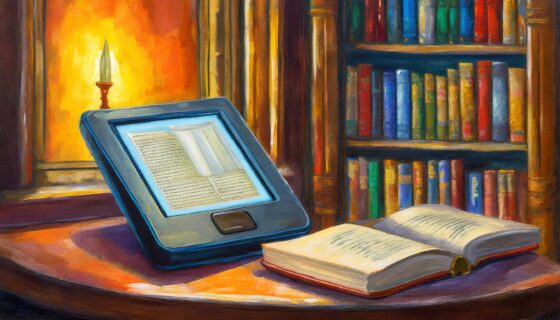Reading opens doors to new worlds, ideas, and perspectives. Yet, for many individuals, the act of reading can be fraught with challenges. Two common obstacles that readers often encounter are difficulty retaining information and the inability to conjure vivid images in their mind’s eye when they traverse text landscapes. Whether you’re conquering fantastical lands on a dragon or navigating the dense terrain of Eastern European history, these struggles can diminish the joy and effectiveness of reading.
These issues don’t just affect personal enjoyment; they can also hinder professional growth and learning. When information slips through the mental cracks, it can frustrate readers, undermining their confidence and ability to engage with more complex material. Similarly, a lack of visualization can render a narrative flat and uninvolving or make conceptual information harder to comprehend.
But there’s good news: the brain is malleable, and improving your retention and visualization abilities is well within reach with the right strategies. This blog post is designed to shed light on these strategies, providing you with a toolkit to transform your reading experience. You’ll learn methods to keep what you’ve read from evaporating into the ether and techniques to paint vivid mental pictures that bring the text to life.
Whether you’re a student, a professional, or a lifelong learner, our goal is to help you retain more of what you read and enjoy the reading process to its fullest. There’s no need to consider yourself a lost cause if the struggles seem all too familiar. With the approaches outlined in this post, you’ll be equipped to tackle any reading challenge head-on. Remember, the journey of a thousand pages begins with a single paragraph—so let’s turn that page together and embark on a quest to unlock the full potential of your reading abilities.

Understanding Why We Struggle with Reading Retention and Visualization
Understanding the challenges in retention and visualization is the first step in overcoming them. By recognizing the factors at play, readers can start tailoring their approach to reading to address these issues head-on.
Comprehension and Retention
Comprehension is the process of extracting meaning from text, while retention refers to the ability to remember and recall what we’ve read. These skills are foundational for effective reading but can often be hindered by several factors. Without understanding the written material, it’s difficult for the brain to deem it important enough to store in long-term memory, leading to poor retention.
Factors Impacting Retention and Information Visualization
Several factors can negatively impact reading retention and the ability to visualize. Cognitive overload, where the brain is bombarded with too much information at once, can lead to retention issues. Distractions, both internal (such as stress or fatigue) and external (like noise or interruptions), can disrupt the focus necessary for both comprehension and retention.
Lack of interest or background knowledge about the subject matter can also make it challenging to form mental images and connections that aid retention. Additionally, the complexity of the text, the reader’s vocabulary, and even the reader’s beliefs about their reading capabilities can all play roles.
Connection Between Visualization and Memory Retention
Visualization can be a potent tool for enhancing memory retention. It’s a cognitive strategy that involves creating mental images or scenarios as you read. This process can bridge the gap between abstract text and concrete understanding. Visualization taps into spatial memory, which is often stronger than other types of memory.
When we visualize, we anchor information to the imagined spatial environment, making it easier to retrieve later. Drawing parallels between new information and existing memories or creating vivid and emotionally resonant images can significantly boost how much of the text we hold onto.
In the following sections, we’ll explore targeted strategies that can turn the tide on reading comprehension woes, giving you the power to remember more and paint those all-important mental pictures with clarity and color.

Strategies for Enhancing Retention
Active reading techniques and intentional strategies can dramatically improve your ability to grasp and remember text information, whether studying for an exam or enjoying a novel. Here, we outline some practical methods that can help enhance your reading retention.
Active Reading Techniques
- Note-taking and highlighting
- Jot down key concepts, themes, and facts, or use a highlighter to mark important passages.
- Develop a personal system of symbols and abbreviations to make note-taking quicker and more meaningful.
- Review your notes shortly after reading to reinforce the material in your memory.
- Summarizing sections or chapters
- After reading a section, summarize the main points in your own words.
- This exercise forces you to process the information more deeply, aiding retention.
- Consider writing down these summaries as a reference for later review.
- Asking questions while reading
- Approach the text with curiosity and an inquisitive mindset.
- Formulate questions before, during, and after your reading to clarify your understanding and interaction with the material.
- Seek answers actively as you read, fostering a deeper engagement with the text.
Improve Concentration
- Choosing a distraction-free environment
- Identify a quiet, comfortable place where you can focus without interruptions.
- Use noise-cancelling headphones or white noise apps if complete silence isn’t achievable.
- Reading during your peak mental energy times
- Determine when you’re most alert and focused during the day and schedule reading sessions during these times.
- Avoid reading when you’re tired or likely to be interrupted.
Utilize Spaced Repetition and Review
- Explaining the spacing effect
- The spacing effect is a phenomenon where information is more easily recalled if learning sessions are spaced out over time rather than crammed into a single session.
- Implementing review sessions after reading
- Set aside time at regular intervals to review notes, summaries, and highlighted sections.
- Use different intervals for reviewing (e.g., one day, one week, one month) to maximize long-term retention.
Linking Text to Prior Knowledge and Experiences
- Draw connections between new information and what you already know or have experienced.
- Relate complex concepts to everyday life or create analogies that resonate with your background.
- This contextual learning helps integrate new knowledge with existing mental frameworks, making it more memorable.
By incorporating these strategies into your reading routine, you will likely see a marked improvement in your ability to retain what you read. Commit to making these techniques a habit, and watch your retention skills strengthen.
Remember, retention is not just about the act of reading itself but embracing a holistic approach that includes active engagement, conducive environments, smart review practices, and the power of connection to past knowledge.

Aiding Visualization for Better Comprehension
Developing the ability to create vivid mental images while reading can enhance comprehension and make the experience more enjoyable. Some individuals have a harder time visualizing what they read, but as with reading comprehension, the brain can learn this over time and with practice. Here’s how you can train your brain to visualize content more effectively.
Creating Mental Imagery
- Tips for vividly imagining scenes and characters
- As you read descriptions, pause to picture the scene in as much detail as possible in your mind.
- Imagine characters with distinct features—consider their voices, movements, and expressions.
- Engage all your senses by thinking about the sights, sounds, and smells described in the text.
- Using the five senses to create a multi-sensory experience
- Go beyond visual images to imagine the tactile sensations, tastes, and sounds associated with what you’re reading.
- This multi-sensory approach can help deepen the visualization and make it more memorable.
Sketching Scenes or Concept Maps
- Benefits of drawing as a comprehension tool
- Sketching scenes, characters, or concepts can help clarify and reinforce your mental images.
- The physical act of drawing can further engage your brain and aid memory.
- Simple methods for those who feel they can’t draw
- Use stick figures, basic shapes, and arrows to represent elements of the text.
- Don’t worry about artistic skill; focus instead on capturing the essence of what you’ve read.
Using Visual Aids
- Utilizing existing illustrations or photos
- Look for images that closely match the content you are trying to visualize.
- Create a mental link between the text and these visual aids to enhance retention and recall.
- Creating your own visual aids, like flashcards or mind maps
- Flashcards can help readers summarize and visualize key information through bullet points or drawings.
- Mind maps provide a visual structure for organizing thoughts and showing relationships between different pieces of information.
Building a Visualization Vocabulary
- Expand your descriptive vocabulary to understand better and picture the text.
- Actively seek out books and passages rich in imagery to practice visualizing.
Multimedia Approaches: Supplementing Reading with Audio or Video
- Consider using audiobooks or listening to a descriptive narration to help form mental images.
- Watch films, shows, or documentaries about your reading material to provide a visual context.
By actively practicing these visualization techniques, you’ll find that the worlds and ideas within texts become more tangible and engaging. Visualization takes practice like any skill, but with time, you can conjure up rich, detailed images that complement and enhance your reading comprehension.

Building a Visualization Vocabulary
Cultivating a robust visualization vocabulary is akin to a painter adding more colors to their palette; it enriches the imagination and allows for a more vivid and detailed reading experience. Here’s how you can expand your descriptive language and thus improve your ability to visualize textual content.
Expanding Your Descriptive Vocabulary
- Make a conscious effort to learn and internalize new descriptive words.
- Use a thesaurus to find synonyms for common adjectives and sensory-based verbs.
- Engage in word-a-day activities or mobile apps to slowly increase your descriptive word bank.
- Practice using these words in your own speech and writing, which can reinforce their meaning and usage.
Engaging with Vividly Written Texts to Train Your Mental Imagery
- Seek out authors and genres known for their descriptive prowess. Poetry, for example, often relies heavily on imagery and can be an excellent training ground.
- When you encounter a particularly vivid description, pause and reread it, taking time to picture the scene or concept in your mind entirely.
- Discuss these passages with friends or in reading groups to hear how others visualize the same text, which might expand your own perspectives.
Multimedia approaches: Supplementing Reading with Audio or Video
- Incorporate visual or auditory material that complements your reading. For example, if you’re having trouble imagining a historical setting, find documentaries or films that depict that era.
- Audiobooks can be especially helpful for those who struggle to visualize from text alone. Listening to a descriptive narrative with tone and emotion in the reader’s voice can stimulate mental imagery.
- Engage in sensory experiences that match the setting of your reading material, such as listening to music from the book’s time period or sampling food that characters might eat.
By methodically enriching your vocabulary and immersing yourself in descriptive language, you’ll be better equipped to paint detailed mental pictures as you read. Remember, visualization doesn’t happen in black and white; it’s a full-spectrum sensory experience. As you build your visualization vocabulary, you’ll remember more of what you read and get more pleasure from the reading experience itself.

Reading Techniques for Different Material Types
Understanding that different types of material often require distinct reading strategies is crucial for both comprehension and retention. Tackling a dense academic paper isn’t the same as breezing through a light-hearted novel, so let’s explore how to adapt your approach to the content at hand.
Fiction vs. Non-fiction Strategies
- Fiction
- Allow yourself to be immersed in the story and connect emotionally with the characters.
- Visualize settings and characters by paying close attention to descriptive passages.
- Enjoy the narrative without rushing, which can help with visualization and emotional engagement.
- Non-fiction
- Focus on identifying the core ideas and facts presented.
- Take notes and create summaries of concepts to solidify understanding.
- Leverage diagrams, charts, and other visual aids provided to anchor abstract information visually.
Adaptation of Strategies for Technical Material or Complex Narratives
- Technical Material
- Break down complex information into smaller, manageable sections.
- Use analogies and metaphors to relate difficult concepts to familiar ideas.
- Engage in problem-solving or practical applications to comprehend and retain technical details.
- Complex Narratives
- Keep a running list of characters and their relationships to avoid confusion.
- Map out timelines or plot points if the narrative structure is intricate or non-linear.
Speed Reading vs. Slow Reading Approaches
- Speed Reading
- Appropriate for skimming material and getting a general idea of content.
- Employ for reading less critical information or familiar topics where detailed comprehension is less necessary.
- Slow Reading
- Take time to absorb and savor each word, which can be especially beneficial for dense or challenging texts.
- Use for deep learning, critical analysis, or simply pleasure reading where full engagement with the text is desired.
By adjusting your reading techniques to match the material type, you’ll find that your ability to visualize and retain information will improve. Always be flexible with your strategies and tailor them to the demands of the text.
Whether you’re navigating the imaginative landscapes of a novel or dissecting the complex data in a scientific study, being mindful of the right approach can make your reading experience far more productive and enjoyable.

Lifestyle Factors That Can Improve Retention and Visualization
Your daily habits and lifestyle choices can significantly impact your cognitive functions, including memory retention and the ability to visualize. Here are some lifestyle tweaks that can help bolster your reading skills.
Importance of Sleep on Memory and Cognition
- Prioritize sufficient and consistent sleep to improve memory consolidation.
- Practice good sleep hygiene, such as maintaining a regular sleep schedule and creating a restful environment.
- Understand that during sleep, the brain processes and reinforces new knowledge acquired during the day.
Nutrition and Exercise as Cognitive Enhancers
- Nutrition
- Include brain-healthy foods in your diet, such as omega-3-rich fish, nuts, berries, and green leafy vegetables.
- Stay hydrated, as even mild dehydration can impair concentration and cognitive function.
- Consider discussing with a healthcare professional about vitamins and supplements known to support brain health, like omega-3s, vitamin D, B vitamins, and antioxidants.
- Exercise
- Engage in regular physical activity, which can stimulate neurogenesis (the creation of new brain cells) and increase blood flow to the brain.
- Include aerobic exercises to boost overall brain function and strength-training activities to combat cognitive decline.
- Use exercise breaks to reflect on your reading, further aiding retention.
Stress Reduction Techniques for Better Focus and Mental Clarity
- Incorporate stress management practices into your routine, such as meditation, deep-breathing exercises, or yoga.
- Tackle stressors proactively by organizing your time and responsibilities, which can help clear your mind for better focus during reading sessions.
- Learn to recognize the signs of stress and have strategies to alleviate it, as high stress levels can negatively affect memory and visualization.
Addressing these lifestyle factors can create a robust foundation for cognitive health that supports your reading goals. A well-rested, well-nourished, and relaxed mind is far more capable of processing, retaining, and visualizing information. Remember, it’s not just about the hours you spend with a book; it’s also about how you care for your brain and body outside of reading that can make all the difference.

Technological Tools and Resources to Aid Reading
In the digital age, technology offers many tools and resources to assist with reading comprehension, retention, and visualization. These technologies can be particularly helpful for readers struggling with these reading aspects. Here are some examples of how technology can support your reading journey.
Apps and Software for Focus and Retention
- Explore apps designed to enhance concentration, such as Pomodoro timers or apps that block distracting websites during designated reading times.
- Use digital note-taking tools with features like tagging, searchability, and cloud syncing to keep your reading notes organized and accessible.
- Consider spaced repetition software (SRS) that schedules reviews of material at optimal intervals to maximize memory retention.
Online Resources to Practice and Improve Visualization Skills
- Discover online platforms that offer guided imagery exercises and visualization practice.
- Utilize websites and apps that encourage creative visualization, like interactive story-building or virtual mind-mapping tools.
- Look for virtual book clubs and forums where readers discuss and share their visual interpretations of texts, providing new perspectives and insights.
Audiobooks and the Role of Listening in Enhancing Comprehension
- Audiobooks can be a powerful tool for those who struggle with visualization, as a skilled narrator’s voice can help conjure up scenes and characters.
- Use audiobooks to complement traditional reading, listening to passages you’ve found particularly challenging to visualize.
- Take advantage of the portability of audiobooks to fit in more ‘reading’ time during commutes, workouts, or household chores.
Implementing technology wisely can amplify the benefits of reading and support various learning styles. From tools that enhance focus to platforms that improve visualization, modern tech offers versatile solutions for common reading woes. Combine these technologies with the strategies discussed earlier, and you’ll be well-equipped to tackle any reading material with confidence and improved comprehension.

Practice and Patience: The Keys to Improvement
Improving your reading retention and visualization capabilities is a process that requires time, dedication, and, above all, patience. With consistent practice, you can cultivate these skills and enjoy enhanced reading comprehension’s profound and long-lasting benefits. Here’s how to approach this personal growth.
Setting Realistic Goals for Reading Improvement
- Define clear, attainable objectives for what you hope to achieve with your reading skills—it’s unrealistic to think that two days of applying these techniques will revolutionize your world. This could be as simple as remembering critical details from a chapter or vividly picturing a scene in a novel.
- Break these goals into smaller, actionable steps you can incrementally build upon.
- Track your progress, celebrate successes, and adjust your strategies as needed.
The Role of Regular Practice in Enhancing Reading Skills
- Incorporate reading into your daily routine, even if it’s just a few pages every day. Consistency is key to building and sustaining new skills.
- Regularly challenge yourself with various reading materials that require different comprehension strategies. Diversity in content keeps the practice engaging and broadens your skills.
- Reflect on your reading experiences and note what visualization and retention techniques are most effective.
Encouraging Patience and Consistency in the Learning Process
- Recognize that improving reading abilities is a journey, not an overnight transformation. Be patient with your pace of learning and avoid self-criticism.
- Understand how long habits take to form; studies show it takes, on average, 66 days for a new habit to become automatic.
- Stay persistent and consistent in your efforts, understanding that some days will be more successful than others.
- Be open to trying different methods and adapting your approach as you discover what works best for you.
Remember, just like any other skill, reading effectively—and getting the most out of your literary adventures—comes with practice over time. By setting achievable goals, practicing regularly, and maintaining a patient mindset, you’ll soon find that you are retaining more of what you read and forming vibrant, lasting images in your mind’s eye. Keep turning the pages, and let your persistence chart the course to a richer reading experience.

Conclusion
As we turn the final page of this guide, let’s reflect on our journey to enhance our reading retention and visualization. Remember, every reader starts with a single word, and every masterful visualizer once struggled to conjure the simplest scene. Reading is an extraordinary tool for growth, knowledge, and escape; it is within every person’s grasp to unlock its full potential.
It’s important to recall that reading is more than decoding words; it’s about engaging with ideas, embarking on adventures, and enriching our minds. Whether you desire to travel through the pages of history, explore the intricacies of new worlds, or simply gain new insights, the strategies outlined here provide the means to reach those destinations and remember the paths you’ve traversed.
From honing active reading techniques to harnessing the power of technology, from integrating lifestyle changes to setting realistic goals—each step of this process is a building block in constructing a more proficient and engaged reader. You now possess a toolkit of strategies ready to be applied and adapted to your individual reading quests.
Let this be your turning point for those who doubt their abilities to become fluent readers or believe it’s impossible to visualize the grand tapestry of a narrative. The magic of reading is not reserved for a select few; it’s a craft that can be developed and a joy that can be cultivated through perseverance and dedication. It’s our human right to access knowledge that can empower our life choices.
Embrace the world of books, not as a far-off land to which you have no map but as a domain you can learn to navigate confidently. The landscapes of literature are vast and varied, and your capacity to explore them is limitless. Revisit these strategies, experiment with them, and watch as the words on the page transform into vibrant memories etched into your mind.
So, as you close this chapter on enhancing your reading skills, remember: the story of your growth as a reader is just beginning. Each page you turn is a step forward; each word retained is a triumph, and every vision blooms in your imagination is a testament to your progress. Keep believing, keep reading, and let the journey unfold. Happy reading!



